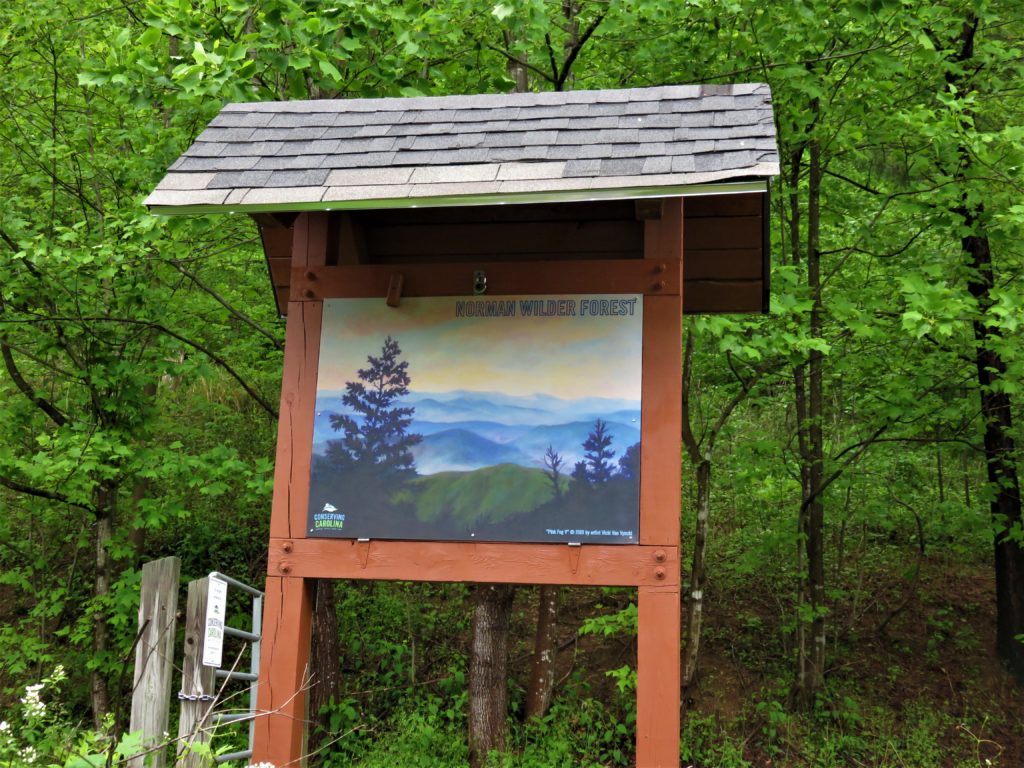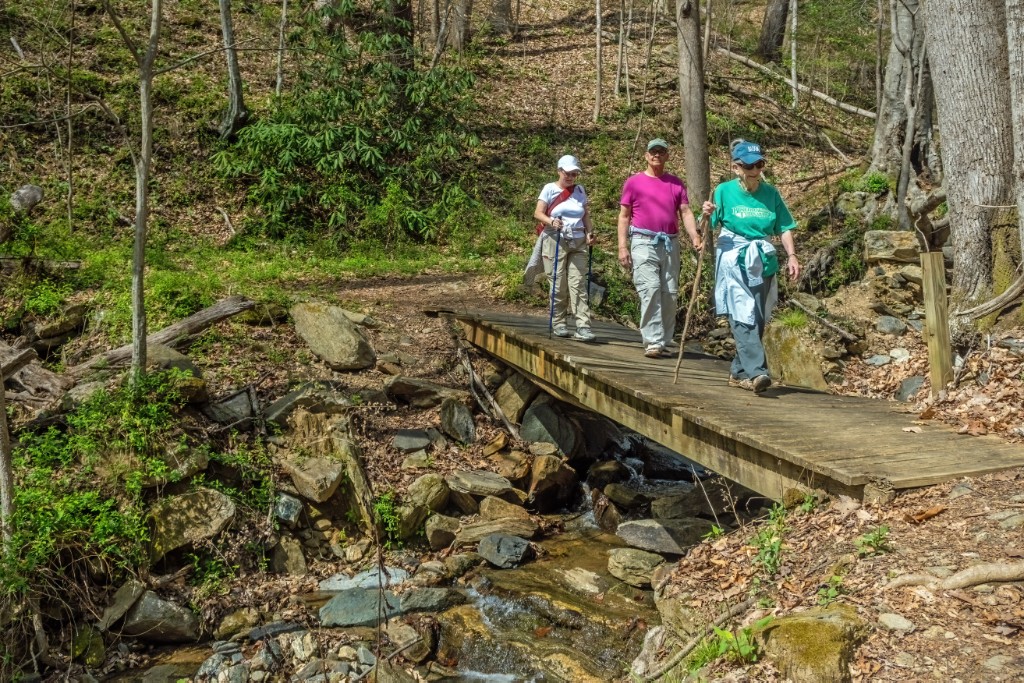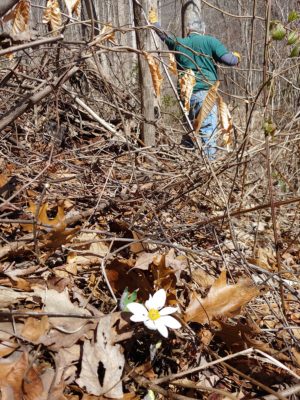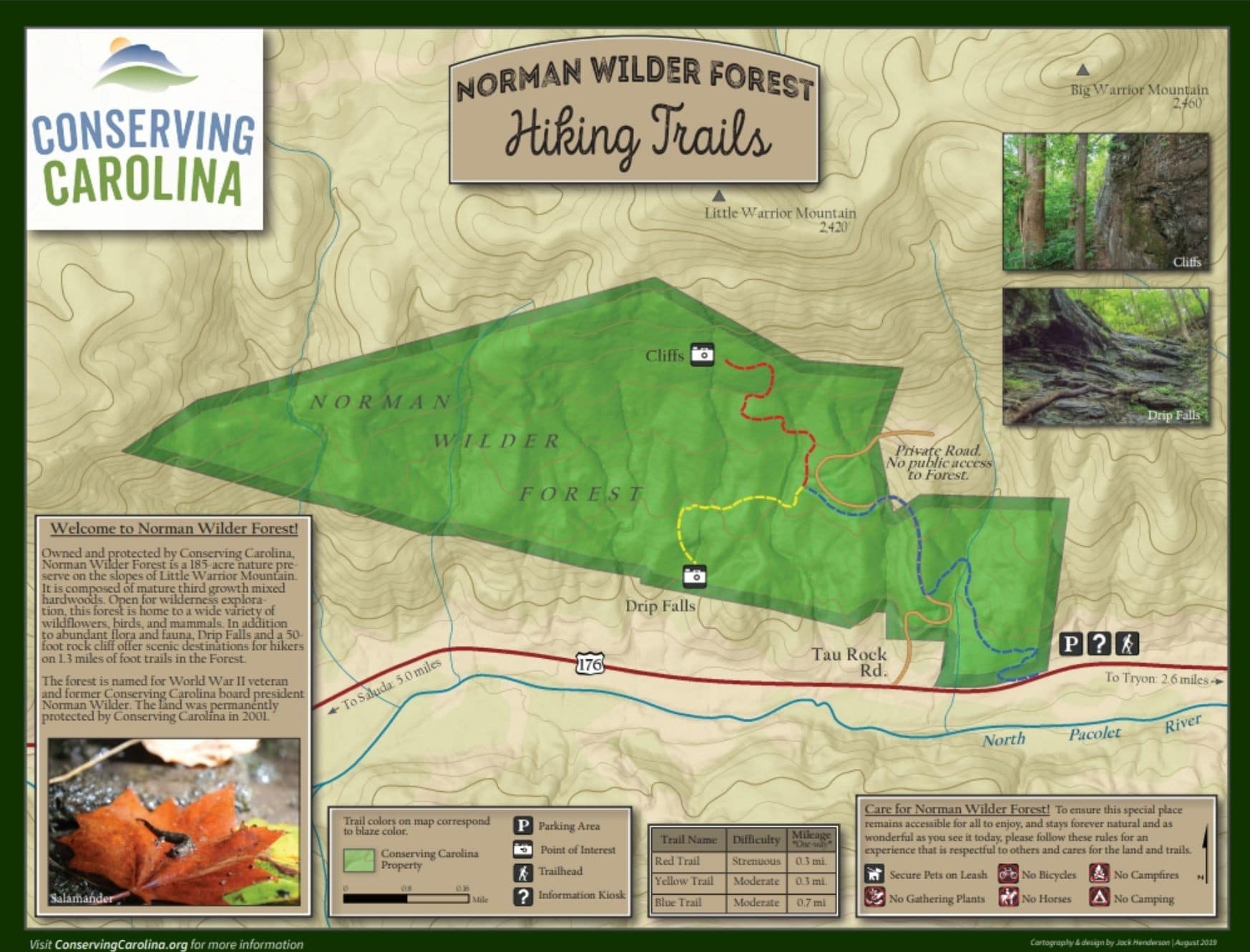Norman Wilder Forest is a 222 acre preserve between Saluda and Tryon. As you explore the hiking trails, you’ll find yourself surrounded by mature forests with majestic, tall trees. In the spring and summer, you can enjoy exceptional displays of wildflowers. The preserve is part of the North Carolina Birding Trail and home to many species including wood warblers, thrushes, and tanagers. Beautiful mountain streams flow through on their way to the North Pacolet River. The trails take you to features including a drip falls, sheer cliffs, and a viewpoint across the river valley.
Length: The most popular hike goes to the drip falls, which is about one mile each way (two miles out and back). If you include the spur trail to the cliffs, there are a total of 1.3 miles of trail (2.6 miles round trip).
Difficulty: Moderate to strenuous. The blue and yellow trails are moderate. The red trail to the cliffs is steep and strenuous.
Great for: Day Hikes,Wildflowers, Bird watching, Kids, Photography, Solitude
Protect More Places for Hiking and Recreation!

If you enjoy places like Norman Wilder Forest, become a member of Conserving Carolina! We’re always working to create new parks, trails, greenways, and public lands. Your membership supports conservation and we’ll keep you in the loop about the latest news, outings, and events.
How to Get to Norman Wilder Forest
Norman Wilder Forest is located on Hwy. 176 between Saluda and Tryon.
Look for this new sign painted by Vicki Van Vyncht on the north side of the road (the side opposite the river). There is a small gravel parking area at the trailhead.

From Hendersonville
Take I-26 East. Take exit 59 with signs for ‘Saluda 176.’ Turn right on Ozone Drive. Go approximately 1 mile. Turn left on Hwy 176. Continue on 176 to the parking area on the left side of the road, near Valhalla, just past Tau Rock Vineyard Road.
From Spartanburg
Take I-26 West. Take exit 67 with signs for ‘Tryon Columbus.’ Turn right into traffic circle. Continue across the bridge and exit right out of the circle, onto Hwy 108, toward Tryon. Then take Hwy 176 west toward Saluda. You will find the parking area on the right, just past Riverview Road.
Norman Wilder Forest Trail Map
Enjoy the trails! You can also download a full-size PDF of this map here.
What to Look for on the Trails
- Drip falls
- 50-foot cliffs with unusual geology
- Spring and summer wildflowers
- Songbirds including wood warblers, thrushes, and tanagers
- Abundant butterflies
- Foundation of an old home
- Terracing from previous use as a winery
- Streambeds scoured by 2018 landslides
Trail Ethics
Please be safe and show respect for other hikers and for the plants and animals that live in the forest.
- Stay on designated trails/areas.
- Keep pets on leash and under control.
- Do not disturb plants, animals, livestock, or other natural or cultural resources.
- No campfires or camping
- No hunting, trapping, or firearms
- Hiking only. No bikes, horses, or motorized vehicles.
- Park in designated areas only. Vehicles outside of this area will be towed at owner’s expense.
- No commercial activity (unless permitted by Conserving Carolina)
- Trail open dawn to dusk
- No alcohol or illegal substances.
- Do not litter. Pack in, pack out. This includes dog poop! Bag your pet’s poop and carry it out with you.
- Hike at your own risk.
Hiking in Norman Wilder Forest

The most popular hike in Norman Wilder Forest leads to the drip falls. From the parking lot, follow the blue trail markers to the yellow trail markers for a moderate, 2-mile round-trip out and back hike. (Previously, the yellow trail formed a loop around the drip falls, but this section of trail was seriously damaged in the 2018 landslides. The yellow trail has been rerouted as an out-and-back.)
For a more strenuous hike, follow the red trail markers (from the intersection with the blue and yellow trails) uphill to see the rock cliffs. This spur trail adds another 0.6 miles round trip to your hike.
How Norman Wilder Forest Was Protected
Conserving Carolina owns Norman Wilder Forest and is committed to maintaining it as a nature preserve for generations to come. The forest is near another preserve owned by Conserving Carolina, Melrose Falls in Saluda. Together, these two preserves help protect the exceptional scenery, extraordinary wildflowers, and clean water of the North Pacolet River Valley.
The 185 acres of Norman Wilder Forest were acquired in 1999 by the Pacolet Area Conservancy, one of two land trusts that merged in 2017 to form Conserving Carolina (learn more.) We acquired this land in two tracts, including 138 acres transferred from The Nature Conservancy and 46 acres purchased with a grant from the Polk County Community Foundation.
The forest was named for a lifelong conservationist and environmental educator who served on the board of the Pacolet Area Conservancy. Before moving to South Carolina, Norman Wilder served as director of the Delaware Fish and Game Department and the Delaware Nature Society. He actually has two natural areas named in his honor! The other is the 4,400-acre Norman G. Wilder Wildlife Area in Delaware.
In May of 2023, an addition 36.5 acres was added to the forest. This addition includes rare wildflowers and streams that flow into the North Pacolet River. It contributes to growing corridors for wildlife along the Pacolet River gorge and across the surrounding mountains. This addition also protects scenic views of Little Warrior Mountain.
Volunteering and Stewardship
It takes ongoing stewardship to pass on natural areas for future generations, and that has been very much the case at Norman Wilder Forest!
Kudzu

By 2011, large sections of Norman Wilder Forest had been taken over by kudzu, an invasive vine that smothers other plants, kills trees, and provides minimal wildlife habitat. A group of volunteers decided they weren’t going to let that happen to the forest. They called themselves the Kudzu Warriors, in part because the forest is located on the slopes of Little Warrior Mountain. Led by our all-star volunteer, Greg Miner, the Kudzu Warriors have been uprooting invasive plants since 2011.
While the fight against invasive plants is ongoing, the Kudzu Warriors can take credit for extraordinary accomplishments. Much of Norman Wilder Forest is now free of kudzu and hikers can enjoy beautiful wildflowers in areas that were once solid kudzu.
VOLUNTEER WITH THE KUDZU WARRIORS
Landslides
In May, 2018, after weeks of intense rain, devastating mudslides tore down the steep slopes of Norman Wilder Forest. The landslides scoured earth down to bedrock and swept away mature forests. The flow of mud, trees, and boulders poured across Hwy 176, knocked a home off its foundation, and killed the woman who lived there. The mudslides also opened chasms in the hiking trails. For safety, Conserving Carolina had to close the forest for over a year.
Numerous service groups helped repair the trails, including Carolina Mountain Club, AmeriCorps Summer of Service, and college groups on alternative spring break. Thanks to many hours of volunteer work, Norman Wilder Forest reopened in the summer of 2019!
Habitat Restoration
In addition, Conserving Carolina staff and Polk County citizens have undertaken a number of habitat restoration projects at Norman Wilder.
- Ford Smith, a Conserving Carolina board member, planted a grove of Restoration Chestnut trees in memory of his late wife, Mara Smith, starting in 2015. These trees are a variety of American Chestnut that has been bred by the American Chestnut Foundation to resist the blight that all but wiped out this once grand tree.
- In May 2015, a pollinator garden was planted in an area formerly covered in kudzu and certified as a Monarch Waystation.
- In October 2015, 50 Lari beetles were released on the property to combat hemlock woolly adelgid, an introduced insect that kills hemlock trees.
- In May 2016, native prairie plants and grasses were planted in an area that was cleared of kudzu in order to stabilize loose soil along a stream.
Keep On Going
We’ve helped protect over 25 places for you to get outside—from vast wilderness areas to local parks and greenways. Check them out!
FIND MORE PLACES TO GET OUTSIDE









